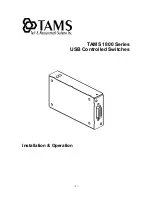
Dell PowerConnect 55xx Systems User Guide
207
DHCP IPv4 Interface
The switch can operate in the following ways:
• It can function as a DHCP client that obtains its own IP from a DHCP
server, as described in this section
• It can function as a DHCP server that allocates IP addresses to other
devices, as described in "DHCP Server" on page 290
When the interface is configured as a DHCP client, it keeps requesting an IP
address from the DHCP server, until it receives one. It then sends Address
Resolution Protocol (ARP) packets to confirm the uniqueness of the IP
address. If the ARP response shows that the IP address is in use, the switch
sends a DHCPDECLINE message to the DHCP server, and sends another
DHCPDISCOVER packet that restarts the process.
IP address collisions occur when the same IP address is used in the same IP
subnet by more than one device. Address collisions require administrative
actions on the DHCP server and/or the devices that collide.
Up to 32 interfaces (ports, LAGs, and/or VLAN) on the switch can be
configured with a static or dynamic IP address. The IP subnets to which these
IP addresses belong are known as directly connected/attached IP subnets.
The IP address assignment rules for the switch are as follows:
• If the IP address on the switch is changed, the switch issues gratuitous
ARP packets to the corresponding VLAN, to check IP address collisions.
• When a client must renew its lease, prior to its expiration date, a
DHCPREQUEST message is sent.
• A specific interface can have either a static IP address or a dynamic IP
address, but not both.
Summary of Contents for POWERCONNECT 5524
Page 415: ...Dell PowerConnect 55xx Systems User Guide 415 ...
Page 728: ......
















































